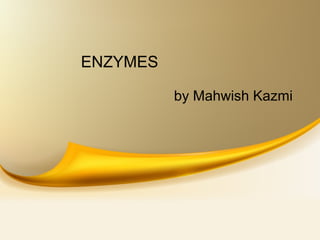
Introduction to Enzymes as Biological Catalysts
- 2. An Introduction to enzymes.... • Biocatalysts - Substances that speed up a chemical reaction without itself being chemically changed at the end of the reaction. • They mainly proteins, produced by living cells. • Louis Pasteur called them as ferments and inseparable from living cells. • Eduard Buchner discovered that these ferments continued to function after removal from cells. • Frederick W. Kühne called these molecules enzymes.
- 3. An Introduction to enzymes.... • James Sumner provided a breakthrough in early enzyme studies with isolation and crystallization of urease. • Haldane made the remarkable suggestion that weak bonding interactions between an enzyme and its substrate might be used to catalyze a reaction.
- 4. Most Enzymes are Proteins • All enzymes are protein except a small group of catalytic RNA • All metabolic and digestive enzymes are protein in nature. • They require some chemical groups for their proper function called Prosthetic group which may be a • Cofactor -- either one or more tightly bound inorganic ions, such as Fe2+ , Mg2+ , Mn2+ , or Zn2+ • Coenzyme -- an easily removed complex organic or metalloorganic molecule, e.g. many vitamins
- 5. • A complete, catalytically active enzyme together with its bound coenzyme and/or metal ions is called a holoenzyme. • The protein part of an enzyme is called the apoenzyme or apoprotein. Human pancreatic amylase
- 6. General characteristics of enzymes 1. Biological catalysts (activity can be regulated), 2. Efficient, specific, stereospecific, 3. Speeds up the rate of a reaction (activation energy) but does not change the equilibrium, 4. Speeds up both forward and reverse reactions, 5. Product purity is 100% (due to reaction specificity - lack of formation of wasteful by-products), 6. Activity is affected by temperature, pH, 7. Inhibited by inhibitors.
- 7. Enzyme Classification • International agreement of biochemists has adopted a system for naming and classifying enzymes. • This system divides enzymes into six classes, each with subclasses, based on the type of reaction catalyzed.
- 8. Enzyme Nomenclature • Each enzyme is assigned a four-part classification number and a systematic name, which identifies the reaction it catalyzes. e.g., ATP:Glucose phosphotransferase catalyzes the transfer of a phosphoryl group from ATP to glucose. Its Enzyme Commission number (E.C. number) is 2.7.1.1.
- 9. Enzyme Nomenclature E.C 2.7.1.1 2 denotes class name (transferase) 7 subclass (phosphotransferase) 1 a phosphotransferase with a hydroxyl group as acceptor; 1 D-glucose as the phosphoryl group acceptor.
- 10. How Enzymes work... • Substrate -- the compound on which an enzyme acts. • Active Site -- Enzyme's specific region where substrate binds and catalysis occurs. Amino acid's R groups play effective role here. • When a substrate binds to an enzyme's active site, an Enzyme-Substrate (ES) complex is formed. • Activation Energy -- an initial input of energy to start reaction. • During this part of the reaction the molecules are said to be in a transition state.
- 13. What is the source of the energy for lowering activation energy? 1. Much of the energy required to lower activation energies is derived from weak, noncovalent interactions between substrate and enzyme's active site. • The energy derived from enzyme-substrate interaction is called binding energy. • Binding energy is a major source of free energy used by enzymes to lower the activation energies of reactions. • The binding energy can be used to cause a conformational change in the enzyme (induced fit). Binding energy also accounts for the exquisite specificity of enzymes for their substrates.
- 14. 2. Rearrangement of covalent interactions between enzymes and substrates lower the activation energy (and thereby accelerate the reaction) by providing an alternative, lower- energy reaction path. • Chemical reactions of many types take place between substrates and enzymes's functional groups (specific amino acid side chains, metal ions, and coenzymes).
- 15. Mechanism of Enzyme Action 1. Lock and Key Model • Propounded by Emil Fisher, • Enzymes are structurally complementary to their substrates, so that they fit together • Like a key fits into a lock very precisely. • Temporary structure called the enzyme-substrate complex formed. • Products have a different shape from the substrate. • Once formed, they are released from the active site. • Leaving it free to become attached to another substrate.
- 16. • Lock and Key Model Enzyme may be used again Enzyme- substrate complex E S P E E P Reaction coordinate
- 17. • Some proteins can change their shape (conformation) so the active site is flexible, not rigid. • When a substrate combines with an enzyme, it induces a change in the enzyme’s conformation. • The active site is then moulded into a precise conformation. • The shapes of enzyme, active site and substrate adjust to maximum fit which improves catalysis. • Making the chemical environment suitable for the reaction. • The bonds of the substrate are stretched to make the reaction easier (lowers activation energy). Induced-fit Model
- 19. Modern notion of enzyme catalysis • Michael Polanyi (1921), Haldane (1930), Linus Pauling (1946) elaborated this concept. • An enzyme must be complementary to the reaction transition state. This means that optimal interactions between substrate and enzyme occur only in the transition state.
- 21. • An enzyme must provide functional groups for ionic, hydrogen-bond, and other interactions, and also must precisely position these groups so that binding energy is optimized in the transition state. • Adequate binding is accomplished most readily by positioning a substrate in the active site where it is effectively removed from water. • The size of proteins reflects the need for superstructure to keep interacting groups properly positioned and to keep the cavity from collapsing.
